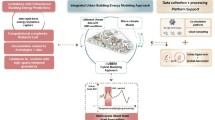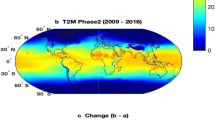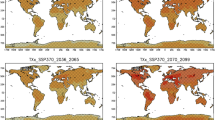Abstract
In the simulation of building overheating risks, the use of typical meteorological years (TMY) can greatly reduce the simulation workload and accurately reflect the distribution of simulation results according to the weather conditions over a given period. However, all meteorological parameters in most current TMY methods use a uniform weighting factor which may make the simulation results against the actual simulation results of the period and negatively affect the accuracy of the evaluation results. In addition to differences in climate characteristics between climate zones, the sensitivity of different simulation results to external parameters will also be different. Therefore, a TMY method based on the Finkelstein-Schafer statistical method is proposed, which considers the climatic characteristics of different regions and the correlation with the output parameters of indoor simulation to select the typical month. The proposed method is demonstrated in the three future scenarios for the three cities in different climate zones in China. The results show that the traditional TMY method has an overestimated weight of solar radiation and wind speed and an undervalued weight of dry bulb temperature when indoor temperature-related indicators are the output target. Compared with the traditional TMY method, the TMY generated by the improved method is closer to the distribution characteristics of the long-term outdoor weather data. Furthermore, when using the improved TMY data to evaluate the overheating performance of the passive residential buildings, the difference of the results of the unmet degree hours, indoor overheating degree, and the overheating escalation factor between the long-term projected data and the TMY data can be reduced by 63%–67% compared with the traditional TMY data.
Similar content being viewed by others
References
Acharya P, Boggess B, Zhang K (2018). Assessing heat stress and health among construction workers in a changing climate: A review. International Journal of Environmental Research and Public Health, 15: 247.
Anderson GB, Bell ML (2011). Heat waves in the United States: mortality risk during heat waves and effect modification by heat wave characteristics in 43 US communities. Environmental Health Perspectives, 119: 210–218.
ASHRAE (2001). ASHRAE Fundamentals Handbook. Atlanta GA, USA: American Society of Heating, Refrigerating and Air-Conditioning Engineers.
Brücker G (2005). Vulnerable populations: Lessons learnt from the summer 2003 heat waves in Europe. Eurosurveillance, 10: 1–2.
Building Bulletin (2003). Building Bulletin 87. Guidelines for Environmental Design in Schools, 2nd edn. Department for Education and Skills, UK.
Buysse DJ, Grunstein R, Horne J, et al. (2010). Can an improvement in sleep positively impact on health? Sleep Medicine Reviews, 14: 405–410.
Cannon AJ (2016). Multivariate bias correction of climate model output: Matching marginal distributions and intervariable dependence structure. Journal of Climate, 29: 7045–7064.
Cannon AJ (2018). Multivariate quantile mapping bias correction: An N-dimensional probability density function transform for climate model simulations of multiple variables. Climate Dynamics, 50: 31–49
Chan ALS, Chow TT, Fong SKF, et al. (2006). Generation of a typical meteorological year for Hong Kong. Energy Conversion and Management, 47: 87–96.
Crawley DB, Barnaby CS (2019). Weather and climate in building performance simulation. In: Building Performance Simulation for Design and Operation, 2nd edn. New York: Routledge.
De Bono A, Peduzzi P, Kluser S, et al. (2004). Impacts of summer 2003 heat wave in Europe. Environment Alert Bulletin, 2: 4
DOE (2018). Prototype Building Models. Building Energy Codes Program. Available at https://www.energycodes.gov/prototype-building-models.
GB (2012). GB50736-2012. Design Code for Heating Ventilation and Air Conditioning of Civil Buildings. Beijing, China: China Architecture and Building Press. (in Chinese)
GB (2019). GB/T51350-2019. Technical Standard for Nearly Zero Energy Buildings. China Academy of Building Research (in Chinese).
Guan H, Soebarto V, Bennett J, et al. (2014). Response of office building electricity consumption to urban weather in Adelaide, South Australia. Urban Climate, 10: 42–55.
Guo S, Yan D, Hong T, et al. (2019). A novel approach for selecting typical hot-year (THY) weather data. Applied Energy, 242: 1634–1648.
Hall IJ, Prairie RR, Anderson HE, et al. (1978). Generation of a typical meteorological year. In: Proceedings of Analysis for Solar Heating and Cooling, San Diego, CA, USA.
Hamdy M, Carlucci S, Hoes P-J, et al. (2017). The impact of climate change on the overheating risk in dwellings—A Dutch case study. Building and Environment, 122: 307–323.
ISO (2005). ISO15927-4:2005. Hygrothermal performance of buildings—Calculation and presentation of climatic data—Part 4: Hourly data for assessing the annual energy use for heating and cooling.
Ji L, Laouadi A, Shu C, et al. (2022). Evaluating approaches of selecting extreme hot years for assessing building overheating conditions during heatwaves. Energy and Buildings, 254: 111610.
Jiang Y (2010). Generation of typical meteorological year for different climates of China. Energy, 35: 1946–1953.
Kershaw T, Eames M, Coley D (2010). Comparison of multi-year and reference year building simulations. Building Services Engineering Research and Technology, 31: 357–369.
Kjellström E, Nikulin G, Strandberg G, et al. (2018). European climate change at global mean temperature increases of 1.5 and 2 °C above pre-industrial conditions as simulated by the EURO-CORDEX regional climate models. Earth System Dynamics, 9: 459–478.
Levermore GJ, Parkinson JB (2006). Analyses and algorithms for new Test Reference Years and Design Summer Years for the UK. Building Services Engineering Research and Technology, 27: 311–325.
Li H, Yang Y, Lv K, et al. (2020). Compare several methods of select typical meteorological year for building energy simulation in China. Energy, 209: 118465.
Li H, Huang J, Hu Y, et al. (2021). A new TMY generation method based on the entropy-based TOPSIS theory for different climatic zones in China. Energy, 231: 120723.
Lima F, Ferreira P, Leal V (2020). A review of the relation between household indoor temperature and health outcomes. Energies, 13: 2881.
Lomas KJ, Porritt SM (2017). Overheating in buildings: lessons from research. Building Research & Information, 45: 1–18.
Lush D, Butcher K, Appleby P (1999). Environmental Design: CIBSE Guide A. Chartered Institution of Building Services
Machard A, Inard C, Alessandrini J-M, et al. (2020). A methodology for assembling future weather files including heatwaves for building thermal simulations from the European coordinated regional downscaling experiment (EURO-CORDEX) climate data. Energies, 13: 3424.
Mandurino C, Vestrucci P (2009). Using meteorological data to model pollutant dispersion in the atmosphere. Environmental Modelling and Software, 24: 270–278.
MPNRC (2021). Canada Heat Wave 2021 Temperature, Deaths, Reason, Map. Available at https://www.mpnrc.org/canada-heat-wave-2021-temperature-deaths-reason-map. Accessed 6 Jun 2022.
Nik VM (2016). Making energy simulation easier for future climate—Synthesizing typical and extreme weather data sets out of regional climate models (RCMs). Applied Energy, 177: 204–226.
Ohunakin OS, Adaramola MS, Oyewola OM, et al. (2013). Generation of a typical meteorological year for north—east, Nigeria. Applied Energy, 112: 152–159.
Pissimanis D, Karras G, Notaridou V, et al. (1988). The generation of a “typical meteorological year” for the city of Athens. Solar Energy, 40: 405–411.
Pusat S, Ekmekçi İ, Akkoyunlu MT (2015). Generation of typical meteorological year for different climates of Turkey. Renewable Energy, 75: 144–151.
Rahman IA, Dewsbury J (2007). Selection of typical weather data (test reference years) for Subang, Malaysia. Building and Environment, 42: 3636–3641.
Santamouris M, Papanikolaou N, Livada I, et al. (2001). On the impact of urban climate on the energy consumption of buildings. Solar Energy, 70: 201–216.
Tham S, Thompson R, Landeg O, et al. (2020). Indoor temperature and health: a global systematic review. Public Health, 179: 9–17.
Vellei M, Ramallo-González AP, Coley D, et al. (2017). Overheating in vulnerable and non-vulnerable households. Building Research and Information, 45: 102–118.
Vimalanathan K, Ramesh Babu T (2014). The effect of indoor office environment on the work performance, health and well-being of office workers. Journal of Environmental Health Science and Engineering, 12: 113.
Wang Y, Liu Y, Song C, et al. (2015). Appropriate indoor operative temperature and bedding micro climate temperature that satisfies the requirements of sleep thermal comfort. Building and Environment, 92: 20–29.
Wang R, Lu S, Zhai X, et al. (2022). The energy performance and passive survivability of high thermal insulation buildings in future climate scenarios. Building Simulation, 15: 1209–1225.
Yang L, Wan KKW, Li DHW, et al. (2011). A new method to develop typical weather years in different climates for building energy use studies. Energy, 36: 6121–6129.
Yaqubi O, Rodler A, Guernouti S, et al. (2022). Creation and application of future typical weather files in the evaluation of indoor overheating in free-floating buildings. Building and Environment, 216: 109059.
Zang H, Xu Q, Du P, et al. (2012). A modified method to generate typical meteorological years from the long-term weather database. International Journal of Photoenergy, 2012: 538279.
Zeng Z, Zhang W, Sun K, et al. (2022). Investigation of pre-cooling as a recommended measure to improve residential buildings’ thermal resilience during heat waves. Building and Environment, 210: 108694.
Zou J, Gaur A, Wang L (2022a). A method of selecting future reference years for indoor overheating assessment. In: Proceedings of Indoor Air 2022, Kuopio, Finland.
Zou J, Gaur A, Wang L, et al. (2022b). Assessment of future overheating conditions in Canadian cities using a reference year selection method. Building and Environment, 218: 109102.
Acknowledgements
The first author gratefully acknowledges the financial support from the Chinese Scholarship Council (CSC No. 202007000086). The authors would like to thank the support of the project of IEA-EBC Annex 80: Resilient Cooling of Buildings.
Author information
Authors and Affiliations
Contributions
All authors contributed to the study conception and design. Material preparation, data collection and analysis were performed by Bin Qian, Li Yang, Tao Yu, Bo Lei. The first draft of the manuscript was written by Bin Qian and all authors commented on previous versions of the manuscript. All authors read and approved the final manuscript.
Corresponding author
Additional information
Declaration of competing interest
The authors have no competing interests to declare that are relevant to the content of this article.
Rights and permissions
About this article
Cite this article
Qian, B., Yu, T., Zhang, C. et al. A method of determining typical meteorological year for evaluating overheating performance of passive buildings. Build. Simul. 16, 511–526 (2023). https://doi.org/10.1007/s12273-022-0967-z
Received:
Revised:
Accepted:
Published:
Issue Date:
DOI: https://doi.org/10.1007/s12273-022-0967-z




